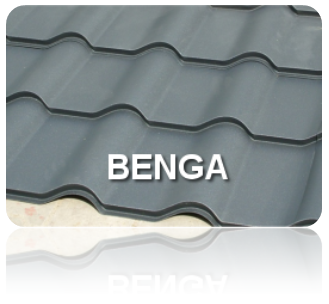Originally published in The Londoner on Thursday, September 29, 2011

London Eco-Roof Manufacturing Inc. president Joe Malec
displays a piece of sheet metal roofing.
Malec is hoping to make sheet metal roofing the industry standard in London.
Everyone appreciates a roof over their head and none more so than Joe Malec. But the London businessman thought there had to be a better alternative to the usual standard shingle roof.
A few years ago he had a metal roof installed on this house. Although he was pleased with the product, the sticker price shock left much to be desired. That is how he began his quest to make metal roofing cost-effective for the average homeowner.
However, it was while he was on a trip to Poland that everything became clear. When looking at the European homes, he marveled at the metal roofs, all of which are commonplace throughout Europe. In fact, metal roofing is more of the standard and it is a rare to find a shingled roof on European home. While there he toured some metal roofing facilities in Poland and went on a fact-finding mission. Upon his return Malec had the formation of a new business, London Eco-Roof Manufacturing Inc.
Malec is one of the co-owners of the mainly family-run company and is the president of Eco-Roof which has been in business for more than two years. “I didn’t like the look of asphalt shingles but metal roofs were so expensive. I thought there had to be a cost-effective alternative,” he said.
Malec says that it is not uncommon to replace standard 20-year asphalt shingles within the first 10 years of installation. However, metal roofing, he said, has a 50year guarantee, a completely transferable warranty for the owner, and a metal roof increases property value.
If metal roofing is the material of choice for Europe and Australia, why not Canada?
That began a four-year planning process for Malec to see if a sheet metal roofing manufacturing business would be viable in London and area.
As far as being environmentally-friendly, the choice is, obvious, said Malec. Typical asphalt shingles are composed of tar, gravel, paper and chemicals. The shingles are not recyclable. Just disposing of the shingles can be expensive for the homeowner.
Whereas metal roofing, once it has run its course, can always be sold to a scrap metal dealer for recycling. “It is very environmentally-friendly and we are also going for an energy star rating. That is in the works,” he said.
A metal roof also increases the value of the house and “it looks great”, he said. “If you drive around London and you see a metal roof, it definitely stands out more than the others. It looks really good … it looks rich and European.”
But keeping the cost within reach of the average homeowner was and still remains a priority for Malec.
Up front costs of a sheet metal roof can be more than three times that of standard asphalt roofing shingles. However, in the long run it is more cost effective, as Malec said that a sheet metal roof will more than likely outlast the period of time the homeowner stays in the house.
Along with the 50-year warranty there is a 40 year guarantee on the integrity of the paint, and what is really stands out for the homeowner is that the warranty is completely transferable should the house be sold.
“Sheet metal roofing with stands all weather conditions, from winter to winds up to 150 kms per hour. And when it rains you will more likely hear the rain on the windows and skylight, than the roof,” Malec said.
A sheet metal roof is very easy to install and is geared to the handi-person, but London Eco-Roof also installs the product that it manufacturers at its 335 Neptune Crescent facility.
The company services communities from Windsor to Ottawa, but everything is manufactured in London.
No job is too big or too small. They have installed sheet metal roofing on mansions, normal sized homes, garages, sheds and yes, even a dog house.
Malec says that he still goes to Poland and researches metal roofing whenever he can, as he always tries to improve the process.
Since the business has been in operation, it has been extremely busy. The plant is capable of producing sheet metal for up to 70 homes per day, “so capacity is not an issue,” Malec said.
London Eco-Roof Manufacturing also provides financing options for homeowners, and he said that up to 20 per cent of the company’s business is financing.
The plant employs approximately 10 people, and the is a sales staff of nearly a dozen employees. Furthermore, there are up to a dozen installers on hand.
A quote is obtained withing 48 hours and the roof is custom-made for the house at the London plant.
Want to know more?
London Eco-Roof Manufacturing Inc. is located at 335 Neptune Crescent in London and the website is www.londonecoroof.com. Contact the company at 519-451-7663 or 1.855.838.9393.




